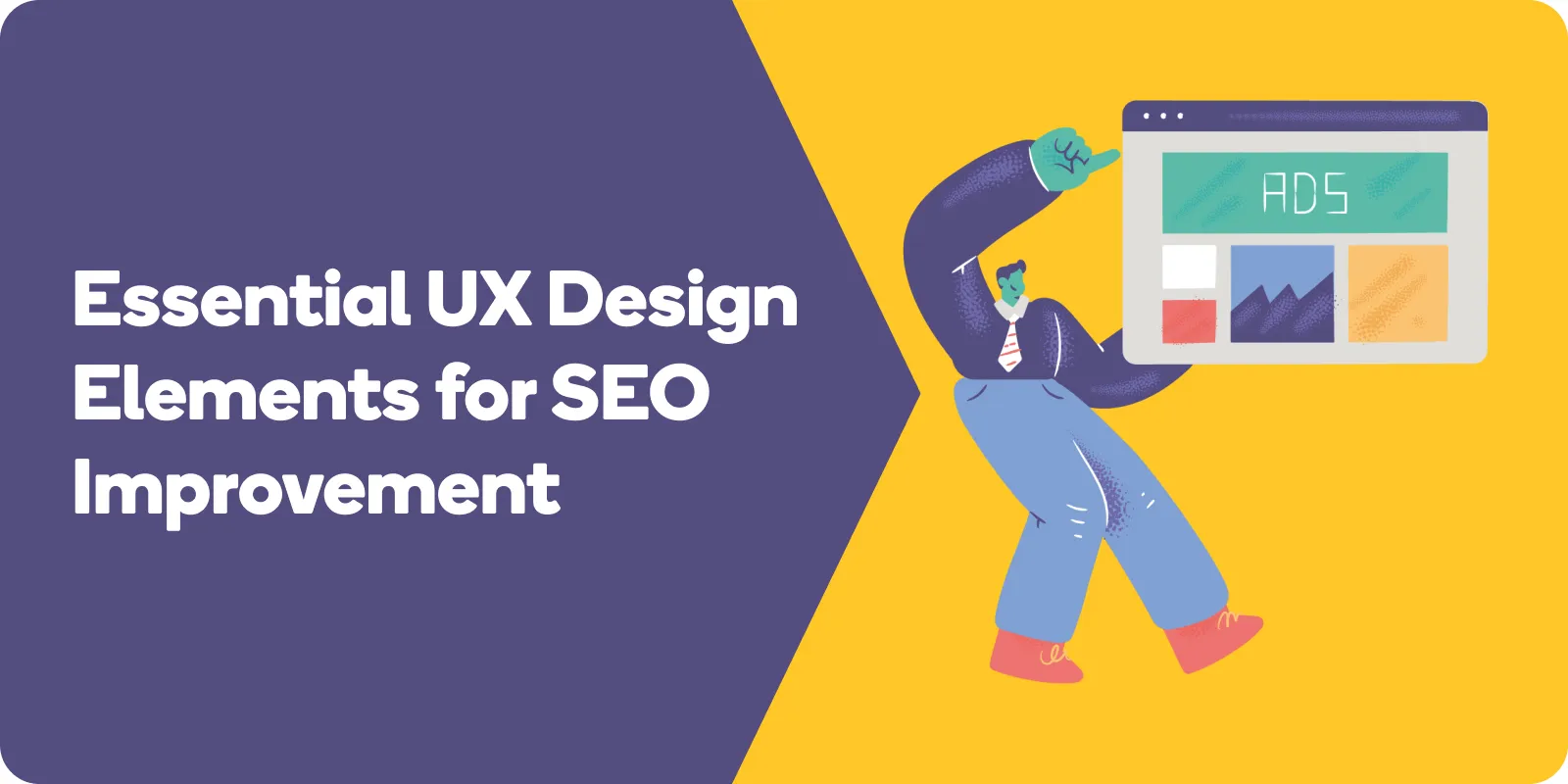In this blog post, we will explore the connection between “SEO and UX: Why User Experience is Crucial for Search Rankings” and unveil how optimizing both can skyrocket your website to new heights.
As we unveil the intertwined relationship between “SEO and UX: Why User Experience is Crucial for Search Rankings,” you’ll discover how essential user engagement metrics contribute to SEO success, the critical UX design elements that can improve your search rankings, and how integrating SEO and UX best practices can lead to optimal website performance.
So let’s dive into the world of SEO and UX and uncover the secrets to creating a website that users love and search engines adore.
The Connection Between SEO and UX
SEO and UX may appear to be two different disciplines, but they share a common goal: enhancing user interaction.
By understanding the correlation between SEO and UX, you can create a website that not only ranks high on search engine results pages, but also provides a rich user experience, encouraging users to spend more time on your site and interact with your content.
Google has adapted its ranking criteria to take user experience into account as a crucial element for SEO.
For years, marketers and designers have debated the relationship between SEO and UX. However, the two disciplines have more in common than meets the eye.
Both strive to improve the way users interact with web pages, creating a seamless experience that keeps them engaged and satisfied.
By optimizing UX, you can also amplify SEO, resulting in higher search rankings and increased organic traffic.
The Importance of User Experience
User experience plays a vital role in determining the success of a website. A well-designed website that fulfills user intent will rank higher in organic search engine results.
This means that the quality of your UX design can directly impact your search rankings. Inadequate web design, convoluted UX, irrelevant content, and slow page speed are some of the factors that could lead to a poor user experience, which in turn, can negatively affect your search rankings.
It’s essential to prioritize user experience when designing a website. By understanding the needs and preferences of your target audience, you can create a website that not only meets their expectations but also keeps them engaged and satisfied.
This will ultimately result in positive user signals, increased user engagement, and improved search rankings.
The Role of SEO
Search engine optimization (SEO) is the process of enhancing a page’s ranking in search engines for relevant keywords.
SEO is vital for increasing website traffic, as 93% of online experiences start with a search engine, and 75% of users do not navigate past the first page of results.
By optimizing your site to conform to search engine algorithms, you can rank higher in search results and attract more organic traffic.
The benefits of SEO cannot be overstated. A well-executed SEO strategy can improve your website’s visibility, drive more organic traffic, and ultimately, increase conversions and sales.
By employing the right SEO techniques, you can help search engines understand your content, rank it higher for relevant search queries, and ultimately, enhance the overall user experience of your website.
Key User Engagement Metrics for SEO Success
User engagement metrics are essential for SEO success, as they provide search engines with the data they need to assess the relevance of a website and its content.
Metrics such as page views, time on page, bounce rate, pages per session, and click-through rate can all influence search rankings. By optimizing these metrics, you can improve your website’s SEO performance and enhance the overall user experience.
Two critical user engagement metrics that have a significant impact on search rankings are bounce rate and dwell time.
Bounce rate refers to the percentage of users who leave a website after viewing only one page, while dwell time is the amount of time a user spends on a page before departing the website.

Award-Winning
Sales Funnel & Website Expert
Ready for Revenue – Not Just “Traffic”?
- Websites that Work: Clean, fast, built to convert – no design fluff.
- Funnels that Sell for You: Step-by-step paths that turn clicks into paying customers.
- SEO That Hunts Buyers: Show up exactly when prospects reach for their wallets.
By optimizing these metrics, you can ensure that your website not only ranks higher in search engine results pages, but also provides a positive user experience for your site visitors.
Bounce Rate and Its Impact on SEO
A high bounce rate can negatively impact your search rankings, as it is taken into consideration by Google’s search ranking algorithm.
Factors that could potentially lead to a high bounce rate include inadequate web design, convoluted UX design, irrelevant content, and slow page speed.
To reduce your bounce rate and improve your search rankings, it’s crucial to address these issues and create a website that keeps users engaged and satisfied.
Strategies that can be utilized to diminish bounce rate include optimizing page speed and load time, guaranteeing mobile friendliness, constructing user-friendly URL structures, generating high-quality and pertinent content, offering intuitive site navigation, and implementing responsive web design.
By focusing on these factors, you can create a website that not only ranks higher in search engine results pages, but also provides an enjoyable and engaging experience for your users.
Dwell Time and Its Significance for SEO
Dwell time is a vital metric for SEO, as it provides an understanding of how captivating the content is, which can have an effect on rankings.
A longer dwell time implies that users find the content valuable and pertinent to their search query, which can have a beneficial effect on SEO rankings.
As a result, optimizing dwell time is crucial for improving your website’s SEO performance and overall user experience.
To optimize dwell time for improved SEO performance, it is advised to optimize page speed and load time, ensure mobile friendliness, craft user-friendly URL structures, and integrate SEO and UX best practices.
By focusing on these factors, you can ensure that your website not only ranks higher in search engine results pages, but also provides a positive user experience for your site visitors.
Essential UX Design Elements for SEO Improvement
User experience is an essential component in search engine rankings, and optimizing UX design elements can assist in optimizing SEO performance.
Factors such as page speed, mobile-friendliness, user-friendly URL structures, content quality and relevance, and intuitive site navigation can have an impact on SEO.
By focusing on these elements, you can ensure that your website not only ranks higher in search engine results pages, but also provides a rich user experience for your site visitors.
In addition to the above factors, it’s crucial to emphasize SEO-compliant designs, incorporate powerful calls-to-action, guarantee rapid loading times, design for mobile-friendliness, and execute a UX/SEO audit to discover possibilities to upgrade the user experience.
By optimizing these UX design elements, you can create a website that not only ranks higher in search engine results pages, but also provides an enjoyable and engaging experience for your users.
Optimizing Page Speed and Load Time
Page speed has a direct influence on user engagement, as it increases the probability of users leaving before accessing the page.
Slow-loading pages can result in a high bounce rate and lowered search rankings. Therefore, optimizing page speed and load time is crucial for both user experience and SEO performance.
Adjusting cache settings, minifying script files, deferring loading of major script files until necessary, and optimizing images are effective methods to optimize website speed.
By implementing these strategies, you can improve your website’s loading speed, reduce bounce rate, and ultimately, enhance both user experience and search rankings.
Ensuring Mobile Friendliness
With the increasing prevalence of mobile devices, it’s crucial to ensure that your website is mobile-friendly.
A mobile-responsive website not only provides a better user experience, but also ranks higher in search engine results pages.
Google’s Mobile-friendly testing tool can be used to evaluate your website’s mobile responsiveness and provide insights on areas for improvement.
By focusing on mobile-responsive design, you can ensure that your website provides an optimal viewing experience across a variety of devices, ranging from desktop computers to mobile phones.
This, in turn, can lead to improved user satisfaction, increased organic traffic, and higher search rankings.
Crafting User-Friendly URL Structures
URL structures play a significant role in SEO, as they can influence a site’s search visibility and ranking. An effective URL structure can boost a site’s position in search results, whereas an inadequate URL structure can impede its ranking.
URLs can also assist search engines in comprehending the content of the page and how it should be presented in search results.
By crafting user-friendly URL structures, you can not only improve your website’s search rankings, but also enhance the overall user experience. Moreover, well-structured URLs make it easier for search engines to crawl and index your website, resulting in better search engine visibility and higher search rankings.
Integrating SEO and UX Best Practices
Integrating SEO and UX best practices is essential for ensuring optimal website performance and user satisfaction. By combining these two disciplines, you can create a website that appeals to both users and search engines, resulting in higher search rankings and increased organic traffic.
Optimal practices for combining SEO and UX include emphasizing SEO-compliant designs, incorporating powerful calls-to-action, guaranteeing rapid loading times, designing for mobile-friendliness, and executing a UX/SEO audit to discover possibilities to upgrade the user experience.
By implementing these strategies, you can create a website that not only ranks higher in search engine results pages, but also provides an enjoyable and engaging experience for your users.
Content Quality and Relevance
High-quality, relevant content is essential for engaging, informing, supporting, and satisfying your target audience.
Crafting genuine, valuable content is paramount for search engine visibility and drawing the right audience to your website.
In addition to improving user experience, content relevance can also help boost search rankings and improve user engagement, if it is useful, accurate, easy to understand, and engaging.
To ensure content quality and relevance, focus on creating content that appeals to both users and search engines.
This includes incorporating clear and concise language, engaging visuals, and informative, valuable information that addresses the needs and preferences of your target audience.
By doing so, you can improve user satisfaction, increase user engagement, and ultimately, enhance your website’s SEO performance.
Intuitive Site Navigation
Clear and easy-to-use site navigation is crucial for ensuring a positive user experience and better search engine indexing. By providing intuitive navigation, you can help users find the information they’re looking for quickly and easily, increasing the likelihood of conversions and user satisfaction.
Site navigation also plays a significant role in helping search engines understand the structure of your website.
By creating a clear and logical site architecture, you can make it easier for search engines to crawl and index your website, ultimately improving your search engine rankings and visibility.
Responsive Web Design
Responsive web design is a critical component of SEO success due to its ability to improve user experience, page loading speed, reduce bounce rate, eliminate duplicate content, and encourage link building.
A mobile-responsive website ensures that your site is accessible and visible across a variety of devices, from desktops to mobile phones. This, in turn, improves your website’s ranking on Google search results pages.
By adopting responsive web design, you can create a website that provides an optimal viewing experience across different devices, ensuring that users can easily access and interact with your content.
This not only enhances user satisfaction, but also contributes to better search engine rankings, increased organic traffic, and long-term success.
Hiring the Right Professionals
Hiring experienced UX designers and SEO specialists can significantly improve your website’s performance and search rankings.
These professionals possess the expertise and knowledge required to optimize your website for search engines while ensuring a seamless user experience.
By engaging the right professionals, you can benefit from their insights and strategies, leading to higher search rankings, increased organic traffic, and long-term success.
Skilled UX designers can create a website that is both user-friendly and optimized for search engines, while SEO specialists can stay abreast of the ever-evolving search engine algorithms and guarantee on-page optimization to generate pertinent search results and a favorable user experience.
By hiring the right professionals, you can ensure that your website is optimized for both user experience and search rankings, resulting in improved site traffic, lead volume, and brand recognition.
Frequently Asked Questions
What is SEO and UX?
Search Engine Optimization (SEO) and User Experience (UX) are two crucial aspects of digital marketing and website design.
SEO is a set of strategies and techniques aimed at increasing the visibility of a website in search engine results pages (SERPs). It involves various practices such as keyword optimization, content creation, link building, and technical SEO like site speed enhancement, mobile optimization, and the use of structured data.
UX, on the other hand, focuses on the overall experience of a user when interacting with a product or service, most commonly a website or an app. It involves designing an interface that is easy to use, intuitive, and enjoyable, thereby enhancing user satisfaction. UX design takes into account aspects such as usability, accessibility, performance, design/aesthetics, utility, ergonomics, overall human interaction, and marketing.
Do UX designers do SEO?
While UX designers are primarily focused on creating a seamless and intuitive user interface, they may indirectly contribute to SEO efforts. For instance, by designing a website that is easy to navigate, UX designers can reduce bounce rates and increase the time users spend on the site, both of which are factors that search engines consider when ranking pages.
Additionally, a well-designed site can encourage users to share and link to it, thereby boosting its SEO. However, the task of optimizing a website for search engines typically falls under the responsibility of SEO specialists or digital marketers.
How does UX relate to SEO?
UX and SEO are interconnected in several ways. From an SEO perspective, search engines like Google aim to provide users with the most relevant and high-quality results for their queries.
Thus, they favor websites that offer a good user experience. Factors such as site speed, mobile-friendliness, easy navigation, and quality content all contribute to a positive UX and are also crucial for SEO.
Moreover, effective UX design can lead to increased user engagement, lower bounce rates, and higher conversion rates, all of which can positively impact a site’s SEO. Therefore, while UX and SEO have different objectives, they work together to enhance the overall quality and performance of a website.
Is UX UI part of SEO?
User Experience (UX) and User Interface (UI) design are not directly part of SEO, but they play a significant role in the success of SEO strategies. UI design, which focuses on the look and layout of a website, and UX design, which focuses on the user’s overall experience, both contribute to the usability and accessibility of a website.
These factors are essential for SEO because search engines like Google consider the usability and user-friendliness of a website when determining its ranking. A website with a well-designed UI and a positive UX is more likely to attract and retain users, reduce bounce rates, increase dwell time, and encourage social sharing and linking, all of which are beneficial for SEO.
What is SEO vs UI UX design?
SEO and UI/UX design are different aspects of a website’s development and performance that serve distinct, yet interconnected, purposes.
SEO is a digital marketing strategy that aims to increase a website’s visibility on search engine results pages. It involves optimizing various elements of a website, including its content, structure, and technical aspects, to make it more appealing to search engines.
UI/UX design, on the other hand, focuses on the user’s interaction with a website. UI design is concerned with the aesthetic elements of a website, such as colors, typography, and layout, while UX design is concerned with the overall user experience, including the website’s functionality, usability, and navigability.
While SEO and UI/UX design serve different purposes, they are closely interconnected. A website with good UI/UX design is likely to rank higher in search engine results.
How to improve SEO with UX design?
Improving SEO with UX design involves a range of strategies that enhance both the user experience and the visibility of a website on search engine results pages. Here are some ways to optimize your UX design for SEO success:
- Improved Site Accessibility: Prioritizing your site navigation and interactivity makes your website more accessible and opens up your page to users of all abilities.
As engagement rises, your SEO rankings will improve. Enhancing user experience and streamlining the customer journey will increase conversion opportunities, speed up your sales funnel, and make your page more desirable for Google’s search engine crawlers.
- Mobile Optimization: With a significant amount of web traffic coming from mobile users, designing for the mobile experience is a key concern for both SEO and UX design professionals.
A responsive design built for mobile accessibility, page speed, and thumb responsiveness will partner well with your SEO strategy and contribute positively to your ranking score.
- Consult The Metrics: The key to providing an excellent user experience is knowing your customers. Using analytic tools such as Google Analytics to perform an audit and determine your site’s current pain points is a great place to start.
For example, the pages with the most engagement could be prime spots for your high-ranking keywords, while the content on low-performing pages could be due for a revamp.
- Navigation Optimization: Your navigation system is one of the most crucial parts of your site’s UX design. Google prioritizes your navigation potential. To remain high in the website hierarchy, you need to make your site easy to crawl and optimize your content and design for streamlined access.
Designing a streamlined navigation, linking your flows from top pages to bottom, and optimizing your navigation bar for Google crawlers are essential steps.
- Visual Appeal and Alt Text: While a successful site needs to be visually appealing, it’s important not to overwhelm your UX design. When implementing visual elements, use user-friendly templates for video content creation and image usage.
Introducing Alt Text to your images makes it easier for Google to index them and increases accessibility for visually impaired users. Including a descriptive alt text caption of no more than 125 words provides search engine crawlers with enough information to understand the visual, boosting your SEO score.
By effectively combining SEO and UX design strategies, you can improve your website SEO and attract more users to your brand or business.
Conlusion
In conclusion, understanding the connection between SEO and UX is crucial for creating a website that not only ranks high in search engine results pages, but also provides an enjoyable and engaging experience for users.
By optimizing user engagement metrics such as bounce rate and dwell time, focusing on essential UX design elements like page speed, mobile-friendliness, and user-friendly URL structures, and integrating SEO and UX best practices, you can ensure that your website stands out among the competition.
Hiring the right professionals, such as experienced UX designers and SEO specialists, can further enhance your website’s performance and search rankings.
Their expertise and knowledge can help you create a website that is optimized for both user experience and search engines, resulting in improved site traffic, lead volume, and brand recognition.
As you embark on your journey to improve your website’s SEO and UX, remember that the key to success lies in striking the perfect balance between these two essential disciplines.
By focusing on both SEO and UX, you can create a website that not only ranks highly in search engine results pages, but also provides a rich user experience that keeps visitors coming back for more.












